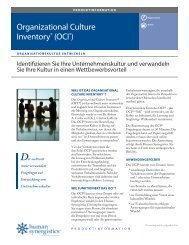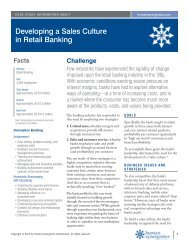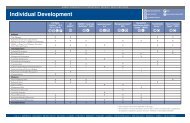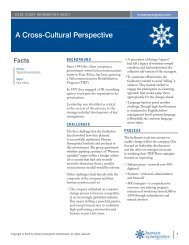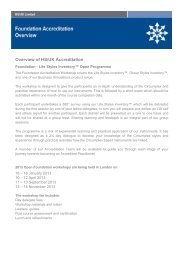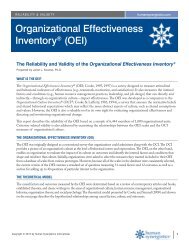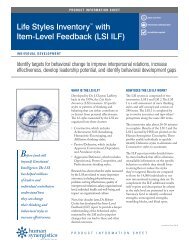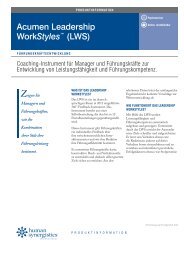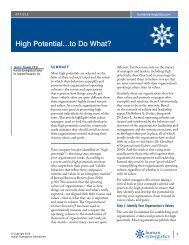AHP Cultural Transformation: Driving Positive Organizational Change
AHP Cultural Transformation: Driving Positive Organizational Change
AHP Cultural Transformation: Driving Positive Organizational Change
You also want an ePaper? Increase the reach of your titles
YUMPU automatically turns print PDFs into web optimized ePapers that Google loves.
CASE STUDY INFORMATION SHEET<br />
humansynergistics.com<br />
<strong>AHP</strong> <strong>Cultural</strong> <strong>Transformation</strong>:<br />
<strong>Driving</strong> <strong>Positive</strong> <strong>Organizational</strong> <strong>Change</strong><br />
Roxanne Ray<br />
Senior Performance<br />
Consultant for Advocate<br />
Health Care<br />
with Eric Sanders<br />
Winner of the 2006 OD Network<br />
Chicago Impact Award<br />
Roxanne Ray of Advocate Healthcare uses the<br />
<strong>Organizational</strong> Culture Inventory ® (OCI ® ) and Life<br />
Styles Inventory (LSI) to drive positive change<br />
Roxanne Ray, Senior Performance Consultant for Advocate Health<br />
Care presented her findings on, “Do We Have What it Takes to<br />
Drive <strong>Positive</strong> <strong>Change</strong>?” at the OD Network Conference in San<br />
Francisco (2006). She demonstrated how assessments could be<br />
used effectively not only to improve individual performance, but<br />
also to drive positive change throughout an organization.<br />
Ray discussed the ways in which leaders shape organizational<br />
culture and how assessments can be used to set baselines and<br />
benchmarks for individuals, groups and organizations. Through the<br />
example of Advocate Health Care, she demonstrated the critical<br />
role of leaders in driving positive organizational change.<br />
Ray developed the following white paper for which she received<br />
the 2006 OD Network Chicago Impact Award. She acknowledges<br />
Human Synergistics by saying, “The whole reason we have a good<br />
change process is because we have solid measurement tools to<br />
track individual and organizational level progress.”<br />
USA Offices Located In:<br />
Chicago - Plymouth/Ann Arbor - San Francisco<br />
info@humansynergistics.com<br />
800.622.7584 (US only)<br />
HSI v. 1.0<br />
3/2012<br />
Changing the World—One Organization at a Time ®<br />
U.S.A. | AUSTRALIA | BELGIUM | BRITISH ISLES | BULGARIA | CANADA | FINLAND | GERMANY | HUNGARY | JAPAN | THE NETHERLANDS | NEW ZEALAND | ROMANIA | SERBIA | SOUTH KOREA
“A key part of the effort is communication about the desired change. It should be frequent, twoway,<br />
and involve all associates, carrying the message of why, what and how change should be<br />
made. ... Most important, learn from the process as it evolves, and be willing to modify plans<br />
to meet the ever-changing needs of the organization.”<br />
<strong>AHP</strong> <strong>Cultural</strong> <strong>Transformation</strong><br />
<strong>Driving</strong> <strong>Positive</strong> <strong>Organizational</strong> <strong>Change</strong><br />
By Roxanne Ray<br />
and Eric Sanders<br />
Do we have what it takes to drive positive<br />
organizational change? OD practitioners<br />
frequently ask this question of themselves,<br />
and of the organizations they assist. The<br />
senior leaders at Advocate Health Partners<br />
(<strong>AHP</strong>), part of Advocate Healthcare, came<br />
face to face with the challenge of driving<br />
a cultural transformation in May of 2005.<br />
This case study reviews the steps taken<br />
to initiate, plan, implement and then<br />
institutionalize a cultural transformation<br />
at <strong>AHP</strong>.<br />
In summary, we found that positive<br />
organizational change works best when<br />
members at all levels are included and<br />
committed. The senior leadership team’s<br />
role is to initiate the transformation, set<br />
the vision, and model the change they want<br />
others to make. The management team’s<br />
role is to translate the vision into a realistic<br />
plan and carry it out. A key part of the<br />
effort is communication about the desired<br />
change. It should be frequent, two-way, and<br />
involve all associates, carrying the message<br />
of why, what and how change should be<br />
made. Set and achieve reasonable goals,<br />
and celebrate their accomplishment. Most<br />
important, learn from the process as it<br />
evolves, and be willing to modify plans<br />
to meet the ever-changing needs of the<br />
organization.<br />
Factors to Initiate <strong>Change</strong><br />
Advocate Health Partners administers full<br />
and partial risk contracts for Medicare and<br />
Commercial products, processing over 1.5<br />
million claims annually for eight Physician<br />
Health Organizations (PHOs), serving over<br />
250,000 managed-care patients for over<br />
3,000 participating providers of healthcare.<br />
<strong>AHP</strong> has two main divisions with a total of<br />
163 associates.<br />
In 2005, two new Vice Presidents<br />
were brought to <strong>AHP</strong>, where they found<br />
a complacent, conventional culture, with<br />
both leaders and staff members locked in<br />
a status quo mentality. An organizational<br />
needs assessment uncovered the following<br />
issues: 1) low productivity and service, 2)<br />
error-ridden manual production, 3) lack<br />
of cooperation between departments and<br />
alignment of business lines, 4) high levels<br />
of dissatisfaction among clients, and 5)<br />
low associate morale, resulting in a poor<br />
reputation in the market.<br />
Interviews with associates at all<br />
levels of the organization revealed the<br />
work environment was “not safe.” People<br />
were afraid to make mistakes because<br />
individuals were blamed for process<br />
problems, which were then aired publicly,<br />
with assumptions prevailing over facts.<br />
Communication across business lines was<br />
difficult and work teams were isolated from<br />
one another, causing well-defined silos,<br />
“turf wars” and complicated workflows.<br />
The organization was bureaucratic, with<br />
a large disconnect between management<br />
and staff. The leaders held only short-term<br />
views, making popular decisions rather<br />
than the correct ones. Protecting the<br />
status quo kept the leaders closed to new<br />
and different ideas, and “too busy” to set<br />
achievement goals.<br />
Given this information, the VPs<br />
realized that they needed to change<br />
the culture of the entire organization,<br />
10 OD PRACTITIONER Vol. 40 No. 1 2008
starting with the leadership team. They<br />
understood that in cultural transformation,<br />
associates at all levels take signals from<br />
the leaders. In interviews, the <strong>AHP</strong><br />
VPs said, “If our leaders are modeling<br />
different behaviors, we will not get to our<br />
desired state.” “We cannot accomplish<br />
the goals of the organization without the<br />
[leadership] culture being what it needs to<br />
be.” Changing the organization’s culture<br />
would require a strong commitment on<br />
the VPs’ part, provision of clear direction,<br />
well-defined goals and the courage to<br />
implement the difficult, but needed<br />
change. Most important, they had to be role<br />
models of the change they wanted in the<br />
organization. The question was whether<br />
the rest of the leadership team, locked in a<br />
status quo mentality for many years, would<br />
be on board with the changes.<br />
<strong>Organizational</strong> Culture Assessment<br />
While culture change was the goal<br />
of the <strong>AHP</strong> leaders in this case, the<br />
motivation was to improve organizational<br />
performance. Given the quantitative<br />
orientation of the <strong>AHP</strong> staff, a quantitative<br />
measure of organizational culture<br />
that could be used to relate culture to<br />
performance was most appropriate for their<br />
objectives. We used Human Synergistics’<br />
<strong>Organizational</strong> Culture Inventory ® (OCI)<br />
(Cooke & Lafferty, 1987).<br />
The OCI measures the operating<br />
cultures of organizations in terms of<br />
behavioral norms or “what’s expected”<br />
of members. It includes 120 statements<br />
describing behaviors that might be<br />
expected or implicitly required of<br />
members of an organization. The results<br />
of the assessment are mapped on a<br />
circumplex—a circular graph divided<br />
into 12 sections like the hours on a clock.<br />
The twelve sections represent twelve<br />
behavioral styles grouped into three<br />
clusters or types of cultures: Constructive<br />
cultures have norms that promote higherorder<br />
satisfaction needs of members,<br />
and have a balance between task and<br />
people orientations; Constructive styles<br />
include Achievement, Self-Actualization,<br />
Humanistic-Encouraging, and Affiliative.<br />
Passive/Defensive cultures have norms<br />
that promote self-protective behavior in<br />
interactions with people; Passive/Defensive<br />
styles include Approval, Conventional,<br />
Dependent and Avoidance. Aggressive/<br />
Defensive cultures have norms that<br />
promote self-protective behavior with<br />
respect to the way that members approach<br />
tasks; Aggressive/Defensive styles include<br />
Oppositional, Power, Competitive and<br />
Perfectionistic. [Cluster descriptions are<br />
from the <strong>Organizational</strong> Culture Inventory,<br />
Copyright © 1987 by Human Synergistics<br />
International. Used by permission.]<br />
<strong>AHP</strong> Data<br />
To initiate the cultural transformation<br />
at <strong>AHP</strong>, two versions of the OCI were<br />
administered to the entire leadership team.<br />
The OCI Current measured the culture at<br />
that time, and OCI Ideal measured what<br />
they felt it should be. The findings revealed<br />
that the predominant organizational styles<br />
were in the moderate range of Constructive<br />
with degrees of Oppositional, Avoidance,<br />
Dependent and Conventional styles<br />
(Figure 1).<br />
We analyzed the organizational<br />
culture by levels to give a clear picture of<br />
the issues to address at each level. The<br />
Director level demonstrated a moderate<br />
passive defensive style with a conventional,<br />
Figure 1: <strong>Organizational</strong> culture profiles for <strong>AHP</strong> leaders in 2005 (OCI Current vs. OCI Ideal)<br />
Advocate Health Partners 2005<br />
Current Culture All Respondents, N=32<br />
Ideal Culture All Respondents, N=32<br />
The profile presented in this and subsequent figures is Copyrighted © by Human Synergistics International and used by permission.<br />
<strong>AHP</strong> <strong>Cultural</strong> <strong>Transformation</strong>: <strong>Driving</strong> <strong>Positive</strong> <strong>Organizational</strong> <strong>Change</strong><br />
11
avoidant tendency. They wanted to protect<br />
their status by using relationships with<br />
others in ways that included “going along,”<br />
and avoiding responsibility for any changes<br />
implemented. The Managers, on the other<br />
hand, were ready for change. They were<br />
very constructive, with a healthy dose<br />
of opposition, which allowed them to<br />
constructively criticize new ideas presented<br />
to them. The Supervisors and Team<br />
Leaders were strong on the constructive<br />
styles with an aggressive tendency, and<br />
thus were ready to develop into even better<br />
leaders.<br />
As the VPs recognized, if the<br />
differences between behavioral styles at<br />
each leadership level were not addressed<br />
early in the cultural change process,<br />
they would lead to greater difficulty in<br />
moving the whole organization toward the<br />
desired Constructive style. Leaders must<br />
model the desired behaviors. Clearly, the<br />
directors needed to be convinced that the<br />
changes they were implementing were<br />
both necessary and desirable. This was the<br />
group with whom we focused our greatest<br />
efforts.<br />
Plan for <strong>Change</strong><br />
We developed the plan for change<br />
understanding that people generally<br />
resist change. They may be afraid of the<br />
unknown. They may be comfortable<br />
with the status quo, and not understand<br />
the need for change. Some people are<br />
inherently cynical about change, while<br />
others doubt there are effective ways to<br />
accomplish the desired change. Often there<br />
are conflicting goals in the organization,<br />
for example, increasing urgency to<br />
accomplish the change and at the same<br />
time cutting costs to remain viable.<br />
Whatever the reason, people resist change.<br />
Addressing the resistance to change<br />
required an increased and sustained<br />
communication that clearly explained why<br />
change was necessary, what the goal was<br />
and how to accomplish it. The lines of<br />
communication were opened so that staff<br />
members at every level could express their<br />
ideas for the planned changes, as well as<br />
their concerns and frustrations. They could<br />
then move from feeling like they can’t<br />
possibly change, to thinking maybe it’s<br />
possible, to finally embracing the change in<br />
what we called a “Let’s Go!” mentality. We<br />
created a broad communication strategy<br />
to develop a Constructive culture—with<br />
a focus on Achievement—and started<br />
addressing the old behaviors that were<br />
blocking the change.<br />
Beyond communication, adopting a<br />
Constructive, Achievement style required<br />
multiple actions: establishing a clear<br />
direction, creating standards of excellence,<br />
establishing performance and behavioral<br />
expectations, seeking solutions to general<br />
issues and then directly addressing<br />
individual problems, and involving the<br />
right people to correct business processes.<br />
The directors became involved in<br />
weekly meetings seeking feedback from<br />
associates on the identified process issues<br />
and their potential solutions. Root cause<br />
analysis was used to streamline and<br />
automate processes across all business<br />
lines. <strong>AHP</strong>’s clients were educated on<br />
changes as they were implemented. Joint<br />
accountability was established between all<br />
directors and interdependencies within and<br />
between departments were identified. One<br />
key to our success was the ability to break<br />
down the barriers between departments<br />
to create greater interdependence. Related<br />
departments were consolidated to facilitate<br />
better collaboration on work processes and<br />
projects, and leaders were moved closer<br />
to the functional areas that they managed.<br />
Communication and workflow improved<br />
markedly simply by putting people who<br />
needed to cooperate closer together.<br />
Measuring the <strong>Change</strong><br />
Specific performance goals were set for<br />
each functional area. The achievement<br />
of goals was measured on “dashboards”<br />
and reported to the staff regularly. As<br />
goals were accomplished, celebrations<br />
were held to recognize both team and<br />
individual efforts—something that was not<br />
done previously. A significant operational<br />
improvement was installing an automated<br />
claim processing system. This required<br />
a large amount of new learning on the<br />
part of most staff members. In addition<br />
Simple recognition of the process people go through in change<br />
helped logic prevail over emotion as situations arose. Just<br />
as steps were taken to automate the processes, steps were<br />
taken to help the staff to adjust to the changes as they were<br />
implemented. This required a conscious effort and a heightened<br />
awareness by all leaders in understanding their impact on<br />
others. It required gaining skills in listening, goal setting,<br />
giving and receiving feedback, becoming open to new ideas<br />
and a willingness to delegate tasks.<br />
to regularly held staff meetings, those<br />
involved received extensive training on<br />
skills required to run the new automated<br />
processes.<br />
Difficulties Encountered<br />
The focus on Achievement required<br />
changes in all aspects of performance, and<br />
quickly. During the year, staff reductions<br />
altered leadership assignments, thus<br />
adding new skill requirements, in addition<br />
to the changes in systems and procedures.<br />
The speed of the changes in both processes<br />
and personnel proved to be too much<br />
“movement” for some staff members<br />
to handle. Communications once again<br />
became inconsistent, resulting in the right<br />
hand not knowing what the left was doing.<br />
As expected, one response to change was<br />
to revert back to familiar old behaviors.<br />
Recognizing this, the leadership team as a<br />
whole worked hard to overcome the “old”<br />
behaviors, and sustain the change effort.<br />
12<br />
OD PRACTITIONER Vol. 40 No. 1 2008
Table 1: Example personal goals set by members of the <strong>AHP</strong> leadership team<br />
SKILL<br />
ACTION<br />
Listening<br />
Delegating<br />
Work Life Balance<br />
Implementing <strong>Change</strong><br />
Leader Development<br />
A key to implementing the change was<br />
leader development. At the individual level,<br />
leaders needed an understanding of their<br />
own role in the culture change process.<br />
Leader development focused on promoting<br />
the personal attributes desired in the<br />
leader, desired ways of behaving, and ways<br />
of thinking or feeling (Day, 2001). Ideally,<br />
this is done using objective assessment,<br />
coaching and feedback. This allows the<br />
individuals to identify potential areas for<br />
insight, growth, and self-improvement,<br />
and increase their overall effectiveness and<br />
performance. At <strong>AHP</strong>, we implemented<br />
a plan to develop the entire leadership<br />
team, which included recognition<br />
of performance and/or behavioral<br />
deficiencies, identification of the causes<br />
through assessments, and action planning<br />
to address the deficiencies.<br />
Life Styles Inventory<br />
The behavioral styles assessment we used<br />
was the Life Styles Inventory (LSI)<br />
(Lafferty, 1988) from Human Synergistics.<br />
This assessment included both a selfevaluation<br />
and several descriptions by<br />
others to identify both individual leaders’<br />
attitudes and their actual behaviors, as<br />
perceived by those around them, using<br />
the same behavioral styles and circumplex<br />
as the OCI. Because of concurrent<br />
development programs across Advocate<br />
as a whole, we also used MBTI ® and<br />
Lominger Voices ® with some individuals,<br />
and had complementary results on those<br />
assessments.<br />
Individual Action Planning<br />
The development process included<br />
coaching the leaders to analyze their<br />
LSI results for gaps between their selfperception<br />
of their style compared to<br />
Practice attentive and active listening<br />
Stop interrupting others<br />
Identify routine and important work that can be delegated<br />
Share responsibility and accountability<br />
Reduce long work hours, delegate more,<br />
go to the fitness center 3 days a week<br />
how others perceive it. Additionally, the<br />
leaders were encouraged to assess how<br />
their style enhanced or hindered the effort<br />
to move towards a strong Constructive<br />
organizational culture. The entire<br />
leadership team was required to develop<br />
individual action plans by choosing one<br />
or two specific measurable goals to work<br />
on over the year. Examples of the types of<br />
goals chosen are shown in Table 1.<br />
In the action planning process, the<br />
leaders involved their peers and everyone<br />
began to support each other in their<br />
changes, resulting in increased ability<br />
to learn from each other. This was a<br />
significant improvement, which helped<br />
break down the barriers between the<br />
departments.<br />
Simple recognition of the process<br />
people go through in change helped logic<br />
prevail over emotion as situations arose.<br />
Just as steps were taken to automate the<br />
processes, steps were taken to help the<br />
staff to adjust to the changes as they were<br />
implemented. This required a conscious<br />
effort and a heightened awareness by all<br />
leaders in understanding their impact<br />
on others. It required gaining skills in<br />
listening, goal setting, giving and receiving<br />
feedback, becoming open to new ideas and<br />
a willingness to delegate tasks.<br />
Institutionalizing <strong>Change</strong><br />
Effective leadership played a vital role in<br />
<strong>AHP</strong>’s change process. Being given the<br />
opportunity to step out of old ways of doing<br />
business enhanced the ability of leaders<br />
to become innovative, increasing their<br />
capacity to imagine new possibilities and<br />
transform ideas into reality. This allowed<br />
leaders to ensure their organization could<br />
continue to serve its clients as their needs<br />
and the business environment change.<br />
The change showed in both the leaders’<br />
individual styles and in the organizational<br />
culture.<br />
Assessment Results<br />
Individual Behavior Assessments<br />
One early advantage to using the OCI and<br />
LSI assessments together was that it gave<br />
the leaders a common language for culture<br />
and the ability to recognize behaviors that<br />
were not Constructive. It also assisted<br />
leaders in focusing their own development<br />
needs. There was an increased willingness<br />
to delegate tasks or ask for assistance,<br />
instead of the old Perfectionistic behavior<br />
of taking on more and more assignments.<br />
Learning from mistakes became very<br />
important—especially learning how to<br />
challenge processes instead of challenging<br />
the people involved. There was more fact<br />
finding and less assumptions being made;<br />
less blaming and more looking for patterns<br />
and trends in the data.<br />
The leaders at <strong>AHP</strong> showed very good<br />
progress when re-assessed with the LSI<br />
one year into the change process. They<br />
had focused on setting and accomplishing<br />
reasonable goals and promoting a more<br />
team-oriented workforce, shifting their<br />
personal styles and the culture of the entire<br />
organization. Table 2 shows the percentage<br />
of leaders with primary behavioral styles in<br />
each of the LSI style groups. The clockwise<br />
shift around the circumplex, from<br />
Passive/Defensive to Aggressive/Defensive<br />
Table 2: Percentage of <strong>AHP</strong> leaders whose primary LSI styles were in each<br />
cluster<br />
2005 2006<br />
21% Constructive 58% Constructive<br />
34% Passive Defensive 31% Passive Defensive<br />
45% Aggressive Defensive 15% Aggressive Defensive<br />
<strong>AHP</strong> <strong>Cultural</strong> <strong>Transformation</strong>: <strong>Driving</strong> <strong>Positive</strong> <strong>Organizational</strong> <strong>Change</strong><br />
13
to Constructive is not uncommon, and we<br />
were delighted to see it here.<br />
As an example of the behavior changes<br />
made by individual leaders, here are the<br />
assessment results and action plan details<br />
from one of the directors (Figure 2). Note<br />
that the directors initially had the highest<br />
resistance to change.<br />
For this director, the means to her<br />
changes in 2006 was her acceptance of the<br />
need to change her Aggressive/Defensive<br />
behavior. She realized that in the long<br />
term it was not effective, and resulted in<br />
great levels of dissatisfaction personally, as<br />
well as among the staff. She has worked<br />
hard at becoming more cooperative, and<br />
now willingly shares her knowledge with<br />
her team members. She has learned to<br />
delegate better, with the desire to reduce<br />
her long work hours, which she no longer<br />
views as a “good thing.” This increased<br />
inclusion of others, better communication<br />
and improved work-life balance was found<br />
in many of the leaders, and accounts for a<br />
large degree of the organizational change<br />
made.<br />
<strong>Organizational</strong> Culture Assessments<br />
Leaders drive positive organizational<br />
change by changing their individual<br />
behaviors, and thus shifting the culture of<br />
the entire organization. The culture change<br />
at <strong>AHP</strong> showed up in both the OCI survey<br />
results and in its business outcomes.<br />
There were small but significant<br />
reductions in the Passive/Defensive<br />
and Aggressive/Defensive styles, while<br />
maintaining the Constructive styles. There<br />
was a staff reduction shortly before the<br />
2006 OCI was administered. Achieving<br />
these good results so close to such a drastic<br />
change demonstrates how well the leaders<br />
are moving their teams toward the desired<br />
culture. Most important, the culture is less<br />
defensive. This difference is highlighted<br />
when we look at the cultural styles of the<br />
different levels of leaders.<br />
In the 2005 OCI survey, the Director<br />
level showed the lowest strength in<br />
constructive styles of any level of<br />
leadership. The leaders used the LSI<br />
to make significant changes in their<br />
own personal behavioral styles. As the<br />
VPs began to push decision-making<br />
downward, the directors began to feel more<br />
empowered in their roles. They moved<br />
from primarily Passive/Defensive styles<br />
to primarily Constructive cultural styles.<br />
In 2005 the most prominent style was<br />
Avoidance; in 2006, the most prominent<br />
cultural style was Achievement. This<br />
is a huge shift in the cultural norms of<br />
the organization, and a testament to the<br />
leaders “walking the talk.”<br />
The team of managers was impacted<br />
by the organizational changes that<br />
included not only changes in procedures<br />
and processes, but changes in their roles.<br />
Modeling the VPs behavior, the directors<br />
have recently identified appropriate<br />
decisions to push downward to the<br />
managers. One recent example of this<br />
empowerment was the delegation of<br />
staffing changes. As a team, the mangers<br />
showed the least movement in their LSI’s<br />
from 2005 to 2006, even while they<br />
experienced the greatest level of staff<br />
reductions. Despite these changes, while<br />
their perception of the organizational<br />
culture is slightly more defensive in<br />
2006 than in 2005, it is still primarily<br />
Constructive.<br />
The supervisor/team leaders were<br />
greatly impacted by the organizational<br />
changes, which required them to<br />
develop new skills in order to perform<br />
the new processes. More authority and<br />
responsibility has been delegated to these<br />
leaders by their managers, and they have<br />
risen to the new challenges. They still<br />
Figure 2: Individual behavior profiles of an example Director from 2005 and 2006 (LSI 2, Description by Others)<br />
Example Director 2005<br />
Example Director 2006<br />
14<br />
OD PRACTITIONER Vol. 40 No. 1 2008
have a primarily Constructive cultural<br />
profile, with the strongest extensions<br />
in the Humanistic-Encouraging and<br />
Affiliative Styles, manifested in a strong<br />
team orientation, a friendly atmosphere<br />
and increased cooperation among staff<br />
members.<br />
Business Results Achieved<br />
None of these leadership behavior and<br />
cultural style changes would be important<br />
or sustained without complementary<br />
improvements in the business results<br />
of the organization. <strong>AHP</strong>’s clients<br />
experienced the greatest positive financial<br />
impact. Significant reduction in turn<br />
around time results (see Table 3) improved<br />
cash flows for the clients, thus increasing<br />
customer satisfaction. At <strong>AHP</strong> directly,<br />
the change in cash flow created by the<br />
improvements reduced interest expenses<br />
from 2005 to 2006 by nearly $100,000.<br />
Other business results included over<br />
400 system corrections. Aligning and<br />
automating the claims processes resulted<br />
in 98% payment of claims on time,<br />
significantly reducing client complaints.<br />
Streamlining the mechanism for process<br />
improvement involved all levels of<br />
leadership and staff, and included audits<br />
to design skill training for the staff. The<br />
increased skill and knowledge development<br />
resulted in a marked increase in the<br />
number of internal promotions. Associate<br />
satisfaction rose to 98%, which was an alltime<br />
high.<br />
In summary, the results achieved at<br />
<strong>AHP</strong> in just one year included:<br />
» <strong>AHP</strong> interest expense was reduced by<br />
nearly $100,000<br />
» Increased percentage of claims filed<br />
electronically<br />
» More claim payments made with in 15<br />
days of filing<br />
» Reduced turnaround time in addressing<br />
pending claims<br />
Table 3: Key Process Indicators for improvement in turn around time (TAT)<br />
1/05 Inventory 1/06 Inventory <strong>Change</strong><br />
TAT<br />
TAT<br />
1. First Pass Rates:<br />
• EDI filing rate 60% 95% 35%<br />
• Paid claims adjudication rate 70% 85% 15%<br />
• Paid claims within 15 days 80% 95% 15%<br />
2. Pending Claims Volume 17,000 3,000 <br />
• Average TAT >90 days
The new systems required education and training for all levels<br />
of staff, the delegation of work to different levels of staff, and<br />
working together in new and different ways. The combination of<br />
better systems, delegation and education improved individual<br />
and organizational performance.<br />
solving efforts on the work processes, and<br />
not the individuals involved. Mistakes<br />
no longer needed to be hidden, but were<br />
addressed as a way to improve processes.<br />
The leaders became proactive rather<br />
than reactive, and changed the status quo.<br />
The new systems required education and<br />
training for all levels of staff, the delegation<br />
of work to different levels of staff, and<br />
working together in new and different<br />
ways. The combination of better systems,<br />
delegation and education improved<br />
individual and organizational performance.<br />
To institutionalize the change, the<br />
leaders continue to guide the change<br />
process, encourage continued employee<br />
growth, and are role models of the desired<br />
behaviors. This requires them to be open<br />
and accepting of feedback, and willing to<br />
delegate on all levels. Most important, as<br />
we learned in the first year, the leaders<br />
must persevere through the tough<br />
moments, keeping the end goal in sight.<br />
Finally, as we have done in this case<br />
study, it is important to take the time to<br />
reflect on what has been accomplished and<br />
how, what has gone well and what could be<br />
done better. There are always lessons to be<br />
learned, which can be used to improve how<br />
leaders can drive positive organizational<br />
change.<br />
References<br />
Cooke, Robert A. & Lafferty, J. Clayton.<br />
(1987). <strong>Organizational</strong> culture<br />
inventory ® . Plymouth, MI: Human<br />
Synergistics International.<br />
Day, David V. (2001). Leadership<br />
development: A review in context. The<br />
Leadership Quarterly, No. 11, 581-614.<br />
Lafferty, J. Clayton. (1988). Life Styles<br />
Inventory. Plymouth, MI: Human<br />
Synergistics International.<br />
Nash, Susan. (1999). Turning team<br />
performance inside out. Palo Alto, CA:<br />
Davies-Black Publishing.<br />
Szumal, Janet. (2003). <strong>Organizational</strong><br />
culture inventory ® Interpretation<br />
& Development Guide. Arlington<br />
Heights, IL: Human Synergistics<br />
International.<br />
Szumal, Janet. (1998). <strong>Organizational</strong><br />
change challenge facilitator’s manual.<br />
Arlington Heights, IL: Human<br />
Synergistics International.<br />
Roxanne Ray, MSMOB, is a<br />
Senior Performance Consultant<br />
with Advocate Health Care. She<br />
is the “principle” consultant<br />
leading the system wide<br />
frontline leader development<br />
program linking learning and<br />
development to organizational<br />
initiatives. She specializes in<br />
organizational change, leadership<br />
assessment, development<br />
coaching and team development.<br />
She holds a Master’s degree in<br />
<strong>Organizational</strong> Behavior from<br />
Benedictine University. Roxanne<br />
can be reached at roxanne.ray@<br />
advocatehealth.com.<br />
Eric Sanders, MA, MBA, is a<br />
Senior Manger, Leadership and<br />
Organization Development at<br />
U.S. Cellular. He is an expert<br />
at showing financial as well<br />
as behavioral results from<br />
OD initiatives. Eric surveyed<br />
organizational culture for many<br />
organizations (including <strong>AHP</strong>)<br />
while with Human Synergistics,<br />
and at U.S. Cellular he helps<br />
servant leaders and their teams<br />
drive culture change. Eric has a<br />
certificate in OD from Benedictine<br />
University, an MA in economics<br />
from Northern Illinois University<br />
and an MBA from the University<br />
of Illinois at Chicago. He can<br />
be reached at eric.sanders@<br />
uscellular.com.<br />
16<br />
OD PRACTITIONER Vol. 40 No. 1 2008<br />
Copyright © 2008 by the Organization Development Network, Inc. All rights reserved.



